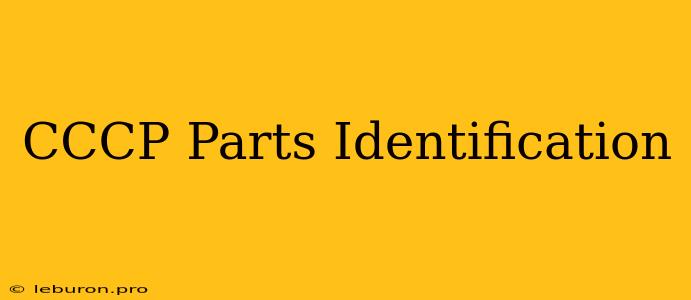The Soviet Union, officially known as the Union of Soviet Socialist Republics (USSR), was a vast and complex nation with a highly developed industrial sector. This resulted in the production of a wide range of machinery, vehicles, and other equipment, many of which are still in use today. However, identifying parts for these machines can be a challenging task due to the unique nomenclature, lack of readily available information, and the difficulty of accessing original documentation. This article will delve into the intricacies of СССР Parts Identification, providing insights and practical tips for navigating this specialized field.
The Challenge of Identifying СССР Parts
Identifying parts from the USSR can be significantly more complex than finding parts for Western-made equipment. The challenges arise from several key factors:
- Language Barrier: Many parts and documentation were originally written in Russian or other Cyrillic languages. Even if you find a part with Cyrillic markings, deciphering the writing without language skills can be a hurdle.
- Lack of Standardization: The USSR had its own unique systems of measurement, material designations, and technical specifications, which differed from international standards. This can make comparing parts to modern equivalents difficult.
- Limited Documentation: Original manuals, schematics, and parts catalogs are often scarce and may be in poor condition. Many resources are held in libraries and archives within the former Soviet republics, making access difficult.
- Obsolete Technology: Many machines and parts from the USSR employed technology that is no longer common. Finding replacements or even understanding the function of these parts can be challenging.
Strategies for Identifying СССР Parts
Despite the challenges, identifying СССР parts is possible with careful research, perseverance, and a combination of strategies:
1. Understanding the Part's Purpose
Before attempting to identify a part, it's essential to understand its function within the machine. This can be achieved through:
- Examining the machine: Observe where the part is located and how it interacts with other components.
- Researching similar machines: If you have a similar machine from a different manufacturer, you can compare the parts and potentially find a match.
- Consulting with experts: Seek out individuals who have experience with Soviet-era machinery, such as retired engineers or collectors.
2. Using Visual Clues
The physical appearance of the part can provide valuable clues for identification:
- Material: Identify the material of the part – steel, cast iron, aluminum, etc. – using a magnet or other tests.
- Shape and Dimensions: Measure the part carefully, noting its dimensions and any unique features.
- Markings: Examine the part for any markings, such as:
- Numbers: These may be serial numbers, part numbers, or manufacturing codes.
- Cyrillic letters: Even without understanding Russian, you can identify unique combinations of letters.
- Logos or symbols: These may indicate the manufacturer or the machine type.
3. Utilizing Online Resources
The internet provides a wealth of resources for СССР Parts Identification. Here are some avenues to explore:
- Specialized Forums and Websites: Online communities dedicated to Soviet-era machinery often offer expert advice and a platform for sharing knowledge.
- Image Search Engines: Use images of the part to search online, as visual matching can be more effective than textual searches.
- eBay and Other Auction Sites: Search for parts listings using keywords in Russian and English, as well as specific machine model numbers.
- Russian-Language Websites: Many websites in Russian may provide valuable information about Soviet-era machines, even if you don't speak the language. Online translation tools can be helpful.
4. Accessing Libraries and Archives
For comprehensive research, consider visiting libraries and archives that specialize in Soviet-era machinery. Some resources to explore include:
- National Archives of the United States: The NARA holds a significant collection of Soviet-era technical documents, including parts catalogs and schematics.
- Libraries of Universities and Research Institutions: Many universities and research institutions, particularly those with Russian language programs, may have collections of Soviet-era technical literature.
- Libraries and Archives in Former Soviet Republics: These may have unique local resources and information about specific factories or machines produced within those republics.
Conclusion
Identifying СССР Parts requires a methodical approach that combines research, visual analysis, and access to specialized resources. While the task may be challenging, it's achievable with patience, perseverance, and a willingness to explore diverse avenues. By utilizing the strategies outlined in this article, you can increase your chances of successfully identifying parts for Soviet-era machines and preserving these valuable pieces of history.
